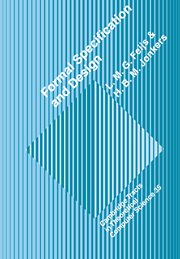
-
Select format
-
- Publisher:
- Cambridge University Press
- Publication date:
- November 2009
- October 1992
- ISBN:
- 9780511569777
- 9780521435925
- Dimensions:
- Weight & Pages:
- Dimensions:
- (247 x 174 mm)
- Weight & Pages:
- 0.558kg, 352 Pages
You may already have access via personal or institutional login
Book description
Formal specification is a method for precisely modelling computer-based systems that combines concepts from software engineering and mathematical logic. In this book the authors describe algebraic and state-based specification techniques from the unified view of the Common Object-oriented Language for Design, COLD, a wide-spectrum language in the tradition of VDM and Z. The kernel language is explained in detail, with many examples, including: set representation, a display device, an INGRES-like database system, and a line editor. Fundamental techniques such as initial algebra semantics, loose semantics, partial functions, hiding, sharing, predicate and dynamic logic, abstraction functions, representation of invariants and black-box correctness are also presented. More advanced ideas, for example Horn logic, and large systems are given in the final part. Appendices contain full details of the language's syntax and a specification library. Techniques for software development and design are emphasised throughout, so the book will be an excellent choice for courses in these areas.
Contents
Metrics
Full text views
Full text views help Loading metrics...
Loading metrics...
* Views captured on Cambridge Core between #date#. This data will be updated every 24 hours.
Usage data cannot currently be displayed.
Accessibility standard: Unknown
Why this information is here
This section outlines the accessibility features of this content - including support for screen readers, full keyboard navigation and high-contrast display options. This may not be relevant for you.
Accessibility Information
Accessibility compliance for the PDF of this book is currently unknown and may be updated in the future.


